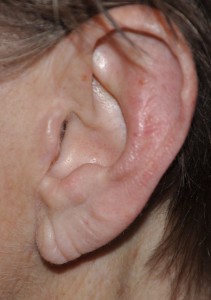
Fat grafting to the face is a well known strategy to manage loss of volume due to aging. While the earlobe is small, could it also be rejuvenated by fat injections?
In the March 2015 Advance Online Issue of the Aesthetic Surgery Jounral, the article entitled ‘Earlobe Rejuvenation: A Fat Grafting Technique’ was published. In this paper the authors assessed before and after results from twenty patients (40 earlobes) who had been treated by fat injections. The earlobes were assessed for volume, number of fine wrinkles and deep creases and total vertical earlobe length with an average followup of over two years. Earlobe fat grafting created improvements in the size of the earlobe and in the reduction of fine wrinkles. But no real improvements were sustained in vertical earlobe length and or deeper linear skin creases. No infections or skin healing problems were seen in any of the patients.
Far grafting has the advantages of being a natural material and one which can be placed virtually anywhere by injection. It remains unpredictable, however, in its survival and retention of volume. But it is well known to have some skin rejuvenation properties which presumably is greatest the more that the fat survives. The earlobe is a very small recipient tissue site so substantial fat graft would not be expected. But this study substantiates that some fat will survive and help provide a bit of rejuvenative effect.
Dr. Barry Eppley
Indianapolis, Indiana


